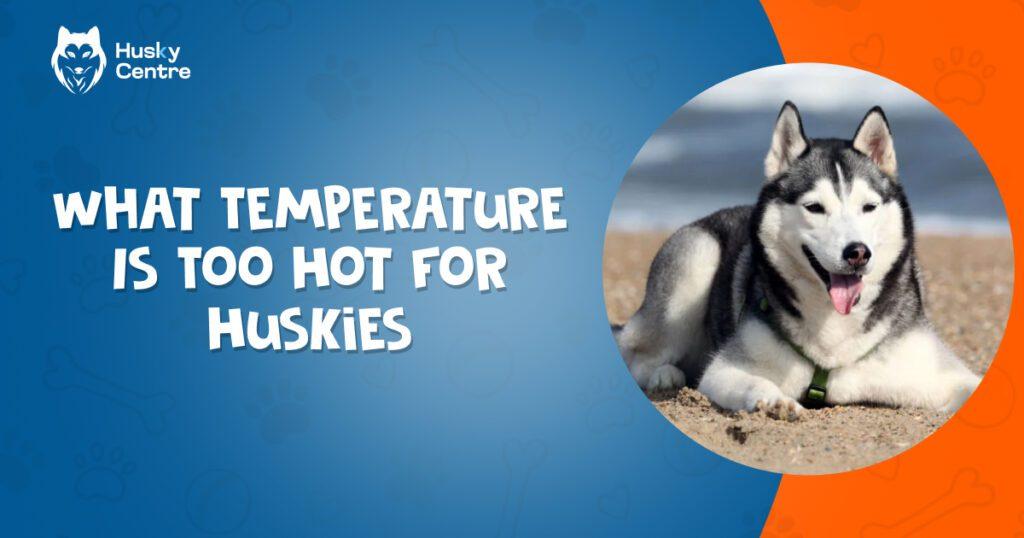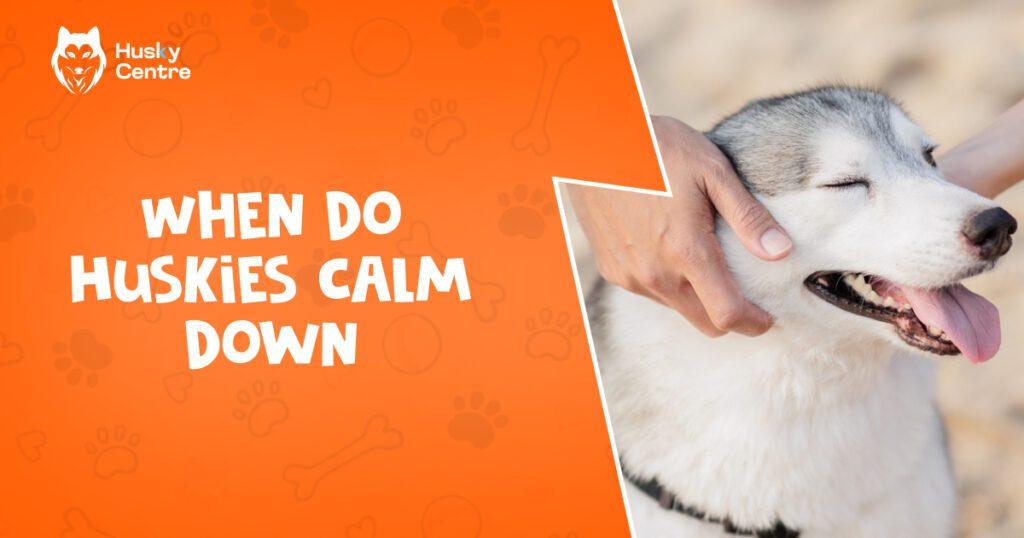Temperatures above 75°F (24°C) are too hot for Huskies. They thrive best in cooler climates.
Huskies are built for cold climates, but they can still enjoy some outdoor fun in warmer weather.pen_spark
Their fur provides insulation against low temperatures, making them susceptible to overheating in warmer conditions. Proper care and precautions become essential as temperatures rise above 75°F (24°C). Adequate hydration, shade, and avoiding strenuous activities during peak heat hours are critical to keep Huskies safe.
This article helps you identify the temperature tipping point for huskies and offers essential strategies for keeping your furry friend cool when the mercury rises.
Ideal Temperature Range For Huskies
Huskies are known for their beautiful, thick coats and boundless energy. Originally bred for cold climates, they thrive in snowy conditions. But what happens when temperatures soar? Understanding the ideal temperature range for huskies is crucial to keep your furry friend comfortable and healthy.
The optimal temperature range for huskies is between 32°F (0°C) and 75°F (24°C). Huskies are well-suited for cooler environments. Their double coat insulates them against the cold, keeping them warm even in freezing temperatures.
Understanding Huskies’ Double Coat
Huskies have a unique double coat that includes a dense undercoat and a longer topcoat. This double coat provides excellent insulation. It keeps them cool in summer and warm in winter. The undercoat sheds during warmer months, allowing better air circulation.
Signs Your Husky Is Too Hot
It’s important to recognize the signs of overheating in huskies. Look for heavy panting, excessive drooling, and lethargy. Other signs include bright red or pale gums and vomiting. If your husky shows these symptoms, move them to a cooler place immediately.
Tips To Keep Your Husky Cool
- Provide plenty of fresh water.
- Ensure shaded areas are available.
- Avoid walks during peak heat hours.
- Use cooling mats or fans.
- Never leave your husky in a parked car.
Safe Exercise Practices
Huskies love to exercise, but in hot weather, it’s essential to adjust their routine. Opt for early morning or late evening walks. Always check the pavement temperature to avoid burning their paws. Shorter, more frequent play sessions are better than long, intense activities.
Creating A Cool Environment Indoors
Indoors, use fans or air conditioning to keep temperatures down. Place cooling mats or wet towels on the floor for your husky to lie on. Ensure your home remains well-ventilated and consider using blackout curtains to block out direct sunlight.
When To Seek Veterinary Help
If your husky exhibits severe symptoms of heatstroke, such as seizures or unresponsiveness, seek immediate veterinary assistance. Quick action can save your husky’s life. Always monitor their behavior closely during hot weather conditions.
Signs Of Overheating
Huskies are known for their love of cold weather, thanks to their thick double coats. But what happens when temperatures rise? Recognizing the signs of overheating in your husky is crucial for their health and well-being. Understanding these signs can help you take action before it’s too late.
Excessive Panting
One of the first signs of overheating in huskies is excessive panting. While panting is normal for dogs, huskies may pant more heavily and rapidly when they’re too hot. Pay close attention to this change in behavior.
Drooling
Another indicator of overheating is excessive drooling. If you notice your husky drooling more than usual, it could be a signal that they are overheating. This is their body’s way of trying to cool down.
Increased Heart Rate
A rapid heartbeat is a serious sign that your husky is overheating. You can check this by feeling your dog’s chest. A faster-than-normal heart rate means you should act quickly to cool them down.
Weakness And Lethargy
Overheating can cause your husky to become weak and lethargic. If your usually energetic dog starts to slow down or shows signs of fatigue, they may be too hot. Provide them with a cool, shaded area and plenty of water.
Vomiting And Diarrhea
In severe cases, overheating can lead to vomiting and diarrhea. This is a clear indication that your husky is in distress. Immediate veterinary attention may be required.
Collapsing
One of the most alarming signs of overheating is collapsing. If your husky collapses, it is an emergency. Take them to a vet immediately. This could be a sign of heat stroke, which is life-threatening.
Dark Or Bright Red Tongue And Gums
A husky experiencing overheating may have a dark or bright red tongue and gums. This is a sign of severe heat stress. It’s essential to cool your dog down and seek veterinary care immediately.
Factors Influencing Heat Tolerance
Huskies are known for their beautiful, thick coats and energetic nature. Yet, these characteristics can make them vulnerable in hot weather. Understanding the factors influencing their heat tolerance can help keep them safe and comfortable. This section explores three key factors: coat type and color, age and health status, and level of physical activity.
Coat Type And Color
The type and color of a Husky’s coat play a significant role in their heat tolerance. Huskies have a double coat, consisting of a dense undercoat and a longer outer coat. This double coat provides insulation against both cold and heat, but it can also trap heat in high temperatures.
Light-colored coats reflect more sunlight, helping Huskies stay cooler. On the other hand, dark-colored coats absorb more heat, making dark-coated Huskies more prone to overheating.
| Coat Type | Heat Tolerance |
| Double Coat | Moderate |
| Light-colored Coat | Higher |
| Dark-colored Coat | Lower |
Regular grooming and brushing can help manage the coat and improve heat tolerance. Removing loose fur reduces insulation, allowing better air circulation.
Age And Health Status
Age and health status significantly impact a Husky’s ability to tolerate heat. Puppies and senior dogs have less efficient thermoregulation, making them more susceptible to heat stress.
- Puppies: Their bodies are still developing, and they can’t regulate temperature well.
- Senior Huskies: Age-related health issues can impair their ability to cool down.
Health conditions like heart disease, respiratory problems, or obesity further reduce heat tolerance. Regular vet check-ups and a balanced diet are crucial for maintaining health and improving heat resilience.
Monitoring their behavior is essential. Signs of heat stress include excessive panting, drooling, lethargy, and even vomiting. Immediate action is necessary if these signs appear.
Level Of Physical Activity
The level of physical activity also affects a Husky’s heat tolerance. Huskies are active dogs that love to run and play, but intense activity in hot weather can quickly lead to overheating.
Moderate exercise during cooler parts of the day, such as early morning or late evening, is safer. Avoid strenuous activities during peak heat hours.
- Morning Walks: Cooler temperatures help prevent overheating.
- Evening Playtime: Allows them to expend energy safely.
- Indoor Activities: Puzzle toys and training sessions can keep them entertained without exposing them to heat.
Always provide plenty of water and shade. A cooling vest or mat can also help keep your Husky comfortable during warmer days.
Indoor Vs. Outdoor Temperature Considerations
Huskies are known for their thick fur and love for cold weather. But, what temperature is too hot for Huskies? It’s crucial to consider both indoor and outdoor temperatures to keep your Husky comfortable and safe. This section will help you understand how to manage temperatures for your furry friend.
Indoor Temperature Considerations
Huskies thrive in cooler environments. Indoor temperatures should ideally be kept below 75°F (24°C). Use fans or air conditioning to maintain a cool atmosphere. Make sure your Husky has access to cool, shaded areas within the house.
If your home tends to be warmer, consider using cooling mats or elevated dog beds. These can help reduce heat retention and provide a comfortable resting place.
| Temperature (°F) | Comfort Level |
| Below 75°F | Comfortable |
| 75°F – 80°F | Moderately Uncomfortable |
| Above 80°F | Uncomfortable |
Outdoor Temperature Considerations
When taking your Husky outside, be mindful of the weather. Temperatures above 80°F (27°C) can be dangerous. Limit outdoor activities during peak heat hours, typically between 10 AM and 4 PM.
Always provide access to fresh water and shaded areas. Avoid hot pavement, as it can burn their paws. Opt for early morning or late evening walks when temperatures are cooler.
- Check the ground with your hand before walking.
- Use cooling vests or bandanas.
- Provide a kiddie pool for quick cool-downs.
It’s vital to recognize the signs of overheating in Huskies. Heavy panting, drooling, and lethargy are common symptoms. If your Husky shows these signs, move them to a cooler area immediately and offer water.
In severe cases, they may experience vomiting, diarrhea, or collapse. These symptoms require immediate veterinary attention. Keeping a close eye on your Husky’s behavior can prevent these dangerous situations.
- Heavy Panting
- Drooling
- Vomiting
- Diarrhea
- Collapse
Tips For Keeping Your Husky Cool
Huskies are known for their thick fur and love for cold climates. But what happens when temperatures rise? Keeping your Husky cool becomes a priority during hot weather. Understanding the right strategies can make a big difference in their comfort and health. Here are some tips to help you keep your Husky cool and happy.
Cooling Strategies
Keeping a Husky cool requires special attention. These dogs have thick double coats, which makes them prone to overheating. Here are some effective cooling strategies:
- Provide Shade: Ensure your Husky has access to shaded areas. Use umbrellas or trees to create a cool spot in your yard.
- Hydration: Always keep fresh water available. Consider adding ice cubes to their water bowl.
- Avoid Peak Heat: Walk your Husky early in the morning or late in the evening. Avoid the midday sun.
- Cooling Mats: Invest in cooling mats. These can provide a cool surface for your Husky to lie on.
- Air Conditioning: Keep your home cool with air conditioning or fans. Make sure your Husky spends time indoors during extreme heat.
Here is a quick overview of these strategies in a table format:
| Strategy | Description |
| Provide Shade | Use umbrellas, trees, or other structures to create shaded areas. |
| Hydration | Always have fresh water available, adding ice cubes for extra cooling. |
| Avoid Peak Heat | Walk your dog during cooler parts of the day, like early morning or late evening. |
| Cooling Mats | Provide cooling mats for your Husky to lie on. |
| Air Conditioning | Keep your home cool with AC or fans, allowing indoor time during extreme heat. |
Exercise caution during hot days. Limit physical activity to prevent overheating. Monitor your Husky for signs of heatstroke like excessive panting or drooling. Groom their fur to remove excess undercoat. This helps air circulate better through their fur.
Precautions For Hot Weather
Huskies are known for their ability to withstand cold temperatures, thanks to their thick double coats. But hot weather can pose a serious risk to these furry friends.
Hydration Is Key
Always provide fresh, cool water for your Husky. Dehydration can lead to heatstroke and other health issues. Keep multiple water bowls around the house and yard. You can also add ice cubes to the water to keep it cool longer.
Limit Outdoor Activities
Avoid taking your Husky for long walks during peak heat hours, typically between 10 AM and 4 PM. Opt for early morning or late evening strolls. Reduce the intensity of physical activities to prevent overheating.
Create Shaded Areas
Ensure your yard has shaded spots where your Husky can rest. Use umbrellas, canopies, or trees to provide shade. Indoors, keep curtains closed to block out direct sunlight.
Watch For Signs Of Overheating
Look out for symptoms like excessive panting, drooling, and lethargy. Check for red gums or vomiting. If you notice these signs, move your Husky to a cooler area immediately.
Use Cooling Products
Invest in cooling mats, vests, or bandanas. These products help regulate your Husky’s body temperature. You can also dampen a towel with cool water and place it on your dog’s body.
Provide Indoor Entertainment
Keep your Husky entertained indoors with toys and games. This reduces the need for outdoor playtime. Puzzle toys and chew toys are excellent options to keep them busy.
Never Leave In A Parked Car
Never leave your Husky in a parked car, even for a few minutes. Cars can heat up rapidly, leading to life-threatening conditions. Always take your dog with you or leave them at home.
How Do You Help A Husky In Heat?
Huskies are known for their thick fur coats and love for cold weather. But what happens when the temperature rises? Many husky owners wonder, “What temperature is too hot for huskies?” In this section, we’ll discuss how to help a husky in heat. Ensuring your husky stays comfortable in hot weather is crucial for their health and well-being.
Provide Plenty Of Water
Always ensure your husky has access to fresh, cool water. Hydration is key to keeping them cool and healthy. Place water bowls in multiple areas around your home.
Create A Shaded Space
Set up a shaded area in your yard where your husky can rest. Use umbrellas, tarps, or shade sails to provide protection from the sun. Avoid direct sunlight as much as possible.
Use Cooling Mats Or Pads
Invest in cooling mats or pads designed for dogs. These products help regulate your husky’s body temperature. Place them in your husky’s favorite resting spots.
Limit Exercise During Peak Heat
Exercise your husky during cooler parts of the day, like early morning or late evening. Avoid strenuous activities during peak heat hours. Keep playtime short and sweet.
Grooming To Reduce Excess Fur
Regular grooming helps remove excess fur, making it easier for your husky to stay cool. Brush your husky frequently to get rid of loose hair and prevent mats.
Monitor For Signs Of Overheating
Watch for symptoms like excessive panting, drooling, or lethargy. Know the signs of heatstroke and act quickly if you notice them. Move your husky to a cool area and offer water immediately.
Keep Indoors Cool
Maintain a cool indoor environment with fans or air conditioning. Keep windows and curtains closed during the hottest parts of the day. Create a cool retreat for your husky inside your home.
| Tip | Description |
| Water | Always provide fresh, cool water. |
| Shade | Create a shaded area for rest. |
| Cooling Mats | Use mats to help regulate temperature. |
| Exercise | Limit activity during peak heat. |
| Grooming | Brush regularly to remove excess fur. |
| Monitor | Watch for signs of overheating. |
| Indoor Cooling | Keep indoors cool and comfortable. |
Frequently Asked Questions
How Hot Can Huskies Tolerate?
Huskies can tolerate temperatures up to 75°F (24°C). Always provide shade and water to keep them cool. They thrive in colder climates.
Can I Walk My Husky In 80 Degree F Weather?
Yes, you can walk your husky in 80-degree F weather. Ensure walks are short, provide water, and avoid peak heat times.
How Do I Know If My Husky Is Too Hot?
Check for excessive panting, drooling, lethargy, or red gums. Ensure your husky has cool water and shade.
What Temperature Should I Bring My Husky Inside?
Bring your husky inside when temperatures drop below 20°F (-6°C). Huskies tolerate cold but need protection from extreme weather.
Conclusion
Huskies thrive in cooler temperatures due to their thick fur. Ensure they stay cool to avoid heat stress. Always provide shade, and water, and limit exercise during hot weather. Monitoring their comfort ensures a happy, healthy Husky. By following these tips, you can keep your furry friend safe and comfortable year-round.


Meet Jarred, the heart and soul behind HukyCentre. With a deep affection for furry friends, he pours his passion into every word he writes. His genuine love for dogs shines through in his engaging and informative content. As a dedicated dog enthusiast, Jarred’s goal is to share valuable insights and tips that resonate with fellow dog lovers. Join Jarred on the journey as he celebrates the joy and companionship that dogs bring into our lives.



